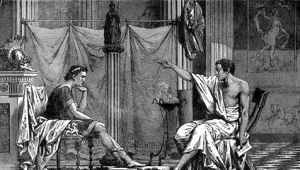Lyceum: Aristotle's Academy
Aristotle's famous Athenian school of philosophy was named the Lyceum. The well-known philosopher founded it in 335 B.C., and the school continued his legacy for another 250 years, ending only when it was destroyed by a Roman contingent led by the general Sulla. The school shared its name with a temple dedicated to Apollo Lyceus, also on the site. The temple predated Aristotle's school; among the famous teachers at the temple were Isocrates, Plato, and Socrates. 
The site, originally a large open space punctuated by shady groves of trees, was also used for athletic training, military exercises, and meetings of the Ecclesia (Assembly); to support this, the Athenians built multiple buildings in the area. The things Aristotle taught became known as peripatetics, some historians say because of Aristotle's habit of walking while he lectured. (The Greek word for walks was peripatoi.) Philosophical study and discussion were encouraged. The Athens establishment revolted against Macedonian overlordship in 322 B.C., and Aristotle and his family fled the city. Theophrastus took over leadership of the Lyceum. Strato followed him; other known subsequent Lyceum leaders included Lyco of Troas, Diodorus of Tyre, and Andronics of Rhodes. Aristotle had built up a considerable collection of manuscripts in the Lyceum library; he had written many of the texts himself. Some sources put the number of rolls of papyrus at 10,000. One of his former students, Neleus, took the manuscripts when we went to Asia Minor, and some of the manuscripts ended up in the Library of Alexandria. The majority, however, passed down through Neleus's descendants and ended up back at the Lyceum, only to be removed for good by Sulla, as part of his sacking of Athens. Some historians have suggested that both Aristotle and Theophrastus, the longest-serving leaders of the Lyceum, were buried on the grounds. No evidence of that has been found. After the Roman occupation of Athens, the Lyceum had one revival, in the 2nd Century A.D. under the philosopher-king prototype Marcus Aurelius, before disappearing into history, after a particularly savage destruction of the city-state in A.D. 267. Excavations in 1996 to make way for the modern city's Museum of Modern Art unearthed remains of the Lyceum, including a gymnasium. An associated museum to showcase the remains opened in 2009.
|
|
Social Studies for Kids
copyright 2002–2025
David White




